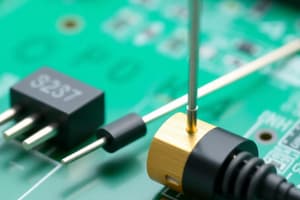Podcast
Questions and Answers
What is the main function of a temperature sensor like the LM35?
What is the main function of a temperature sensor like the LM35?
- To detect motion in an area
- To measure humidity in the environment
- To sense temperature and output it as voltage (correct)
- To convert light into electrical energy
Which statement accurately describes the difference between digital and analog signals?
Which statement accurately describes the difference between digital and analog signals?
- Digital signals can represent a full range of values, while analog signals are limited to ON or OFF states.
- Analog signals are discrete while digital signals are continuous.
- Microcontrollers typically process analog signals, whereas digital signals are processed by sensors.
- Digital signals are ON or OFF, while analog signals can represent a full range of values. (correct)
Where does the power for the LM35 temperature sensor connect?
Where does the power for the LM35 temperature sensor connect?
- GND for negative power and VIN for positive power (correct)
- Vout for negative power and VIN for positive power
- VIN for negative power and GND for positive power
- Vout for positive power and GND for negative power
What type of values does the LM35 output?
What type of values does the LM35 output?
Which phrase best describes how Arduino interacts with the LM35 sensor?
Which phrase best describes how Arduino interacts with the LM35 sensor?
Which of the following correctly defines an analog signal?
Which of the following correctly defines an analog signal?
When wiring the LM35, which pin would be used for output?
When wiring the LM35, which pin would be used for output?
What is the role of microcontrollers in relation to sensors like the LM35?
What is the role of microcontrollers in relation to sensors like the LM35?
What advantage does the LM35 sensor have compared to digital sensors?
What advantage does the LM35 sensor have compared to digital sensors?
In programming, which construct is often used to control actions based on sensor readings?
In programming, which construct is often used to control actions based on sensor readings?
Flashcards are hidden until you start studying
Study Notes
Sensors
- Role: Sensors detect external stimuli and convert them into signals that can be interpreted by a device.
- Examples: Temperature, light, pressure, motion, and sound sensors.
- Functionality: Sensors use physical properties, such as electrical resistance or capacitance, to measure environmental factors.
Temperature Sensors
- LM35: A common and widely used temperature sensor.
- Operation: The LM35 outputs temperature data as an analog voltage signal.
- Pins:
- VIN: Positive power supply pin.
- GND: Negative power supply pin.
- Vout: Output pin that provides the voltage reading proportional to the sensed temperature.
Analog vs. Digital
- Analog Signals: Continuous values, representing a range of possibilities.
- Digital Signals: Discrete values, representing only ON/OFF states (0 or 1).
- Arduino Interpretation: Arduino, a microcontroller, interprets analog signals by reading their voltage levels.
Arduino Reading
- Analog to Digital Conversion (ADC): Arduino uses an ADC to convert analog input signals (from the sensor) into digital values that it can process.
Wiring the Sensor
- Connection: Correct connection of the LM35 sensor to the Arduino is essential for accurate readings.
- Diagram: A wiring diagram provides a visual representation of how to connect the sensor to the Arduino.
Studying That Suits You
Use AI to generate personalized quizzes and flashcards to suit your learning preferences.




